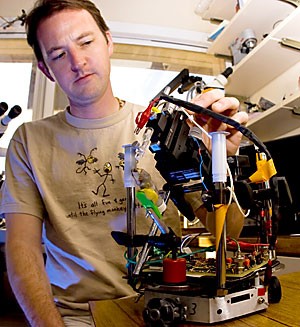A UA professor has hooked up a robot to the brain of a moth, enabling it to move with precision and orient itself to follow a pattern.
Charles Higgins, associate professor of electrical engineering and neurobiology, has created a way to use the electrical impulses from a moth’s brain to control the movements of a robot in the same way the moth would normally control its own muscles.
This achievement has far-reaching implications for the future of everything from explosives-detection to bridging the gap between organic and silicon-based computing in ways that currently lie in the realm of science fiction.
Higgins presented his work last week at the Society for Neuroscience’s annual meeting in San Diego.
“”The idea occurred to me a few years ago,”” he said.
Higgins had previously worked with other types of insects but wanted one that was small and cheap yet larger than the flies he had previously selected. He decided on the tobacco hornworm moth, also known as the hawk moth.
The UA has a moth colony used for research, for which each moth costs only $4, Higgins said.
In the experiment, a tungsten needle was coated with Teflon, a non-stick coating, up until the very end of the needle, which housed an electrode. The needle was inserted into a moth’s brain and connected to just one cell.
“”It had to be within a few microns,”” Higgins said.
Timothy Melano, a biomedical engineering doctoral student who performed the procedure, used a micromanipulator to place the needle just right. It took 10 months and the advice of an Australian professor for Melano to learn the proper technique.
“”We went through dozens, probably,”” he said of their practice moths.
The moth was placed in a plastic tube and glued to the side with a drop of wax to prevent it from moving.
When an object moved across the moth’s field of vision, the signal to follow the object went to the robot, moving it instead of the moth, Higgins said.
“”I think it’s pretty great to interface insects and technology,”” Melano said.
If made as a commercial device, the whole system would cost about $300, Higgins said, adding that its potential is enormous.
Moths, with their incredible olfactory sense, could be used in some terrain to guide robots toward or carry explosives, he said.
Higgins said he believes such applications could become reality within the next few years.
Uses may also branch into medicine.
People who have perfectly functional brains and limbs but are paralyzed due to a break in their spinal cords might be able use “”neuroprostheses”” to bypass the traditional means of controlling the body, making their injuries irrelevant, Higgins said.
If someone’s limbs are missing or unable to be used, robotic grafts could be substituted and controlled by a moth-based system or something similar, he said.
There are definitely ethical issues in using the technology on humans, which have yet to be addressed, Higgins said, but using animals could also benefit people with disabilities.
For example, hooking up the sight of an animal to a human might enable someone to see. Attaching the sensory information of an animal, like a rat, to a wheelchair could help someone navigate.
“”It’s possible in potential,”” Higgins said.
He described how “”neural implants”” might become standard for people like Air Force pilots so they could control their planes from a distance, although he referred to that as “”an evil application.””
Although there are many hurdles to surmount before these ideas become reality, “”there a lot of people working on this,”” Higgins said, and it may just be a matter of time.
The next step, he said, is to use four electrodes and tap into 10 to 60 neurons, which will enable researchers to tap into more of the moth’s sensory perception, like tracking with two eyes.
The breakthrough experiment involved the sight of only one of the moth’s eyes.
Higgins said he also wants to lengthen how long the connection can be contained. Over time, bodies reject foreign objects “”or surround them with fluid, which is what we call an infection,”” he said.
Technical challenges remain, but Higgins is confident that “”eventually, we will understand brains to the point of dealing with them.””
Melano, who plans to graduate in May, said for his next research project, he will likely work on spatial recognition and decision-making in primates or make computers that act like organic brains.









